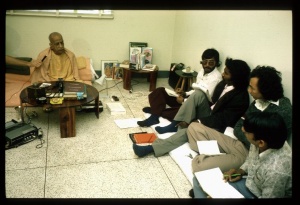CC Madhya 4.12: Difference between revisions
m (1 revision(s)) |
No edit summary |
||
| Line 1: | Line 1: | ||
{{ | [[Category:Sri Caitanya-caritamrta - Madhya-lila Chapter 04|C012]] | ||
<div style="float:left">'''[[Sri Caitanya-caritamrta|Śrī Caitanya-caritāmṛta]] - [[CC Madhya|Madhya-līlā]] - [[CC Madhya 4|Chapter 4: Śrī Mādhavendra Puri's Devotional Service]]'''</div> | |||
<div style="float:right">[[File:Go-previous.png|link=CC Madhya 4.11|Madhya-līlā 4.11]] '''[[CC Madhya 4.11|Madhya-līlā 4.11]] - [[CC Madhya 4.13|Madhya-līlā 4.13]]''' [[File:Go-next.png|link=CC Madhya 4.13|Madhya-līlā 4.13]]</div> | |||
{{CompareVersions|CC|Madhya 4.12|CC 1975|CC 1996}} | |||
{{RandomImage}} | |||
==== TEXT 12 ==== | ==== TEXT 12 ==== | ||
<div | <div class="verse"> | ||
pathe baḍa baḍa dānī vighna nāhi kare | :pathe baḍa baḍa dānī vighna nāhi kare | ||
tā’ sabāre kṛpā kari’ āilā remuṇāre | :tā’ sabāre kṛpā kari’ āilā remuṇāre | ||
</div> | </div> | ||
| Line 12: | Line 16: | ||
==== SYNONYMS ==== | ==== SYNONYMS ==== | ||
<div | <div class="synonyms"> | ||
''pathe''—on the way; ''baḍa baḍa''—big, big; ''dānī''—toll or tax collector; ''vighna''—hindrances; ''nāhi''—not; ''kare''—make; ''tā’ sabāre''—to all of them; ''kṛpā kari’''—showing mercy; ''āilā''—reached; ''remuṇāre''—the village known as Remuṇā. | |||
</div> | </div> | ||
| Line 19: | Line 23: | ||
==== TRANSLATION ==== | ==== TRANSLATION ==== | ||
<div | <div class="translation"> | ||
There were many rivers on the way, and at each river there was a tax collector. The tax collectors did not hinder the Lord, however, and He showed them mercy. Finally He reached the village of Remuṇā. | There were many rivers on the way, and at each river there was a tax collector. The tax collectors did not hinder the Lord, however, and He showed them mercy. Finally He reached the village of Remuṇā. | ||
</div> | </div> | ||
| Line 26: | Line 30: | ||
==== PURPORT ==== | ==== PURPORT ==== | ||
<div | <div class="purport"> | ||
There is a railway station named Baleśvara, and five miles to the west is the village of Remuṇā. The temple of Kṣīra-corā-gopīnātha still exists in this village, and within the temple the samādhi tomb of Rasikānanda Prabhu, the chief disciple of Śyāmānanda Gosvāmī, can still be found. | There is a railway station named Baleśvara, and five miles to the west is the village of Remuṇā. The temple of Kṣīra-corā-gopīnātha still exists in this village, and within the temple the ''samādhi'' tomb of Rasikānanda Prabhu, the chief disciple of Śyāmānanda Gosvāmī, can still be found. | ||
</div> | </div> | ||
__NOTOC__ | |||
<div style="float:right; clear:both;">[[File:Go-previous.png|link=CC Madhya 4.11|Madhya-līlā 4.11]] '''[[CC Madhya 4.11|Madhya-līlā 4.11]] - [[CC Madhya 4.13|Madhya-līlā 4.13]]''' [[File:Go-next.png|link=CC Madhya 4.13|Madhya-līlā 4.13]]</div> | |||
__NOTOC__ | |||
__NOEDITSECTION__ | |||
Revision as of 13:53, 25 July 2021

A.C. Bhaktivedanta Swami Prabhupada
TEXT 12
- pathe baḍa baḍa dānī vighna nāhi kare
- tā’ sabāre kṛpā kari’ āilā remuṇāre
SYNONYMS
pathe—on the way; baḍa baḍa—big, big; dānī—toll or tax collector; vighna—hindrances; nāhi—not; kare—make; tā’ sabāre—to all of them; kṛpā kari’—showing mercy; āilā—reached; remuṇāre—the village known as Remuṇā.
TRANSLATION
There were many rivers on the way, and at each river there was a tax collector. The tax collectors did not hinder the Lord, however, and He showed them mercy. Finally He reached the village of Remuṇā.
PURPORT
There is a railway station named Baleśvara, and five miles to the west is the village of Remuṇā. The temple of Kṣīra-corā-gopīnātha still exists in this village, and within the temple the samādhi tomb of Rasikānanda Prabhu, the chief disciple of Śyāmānanda Gosvāmī, can still be found.